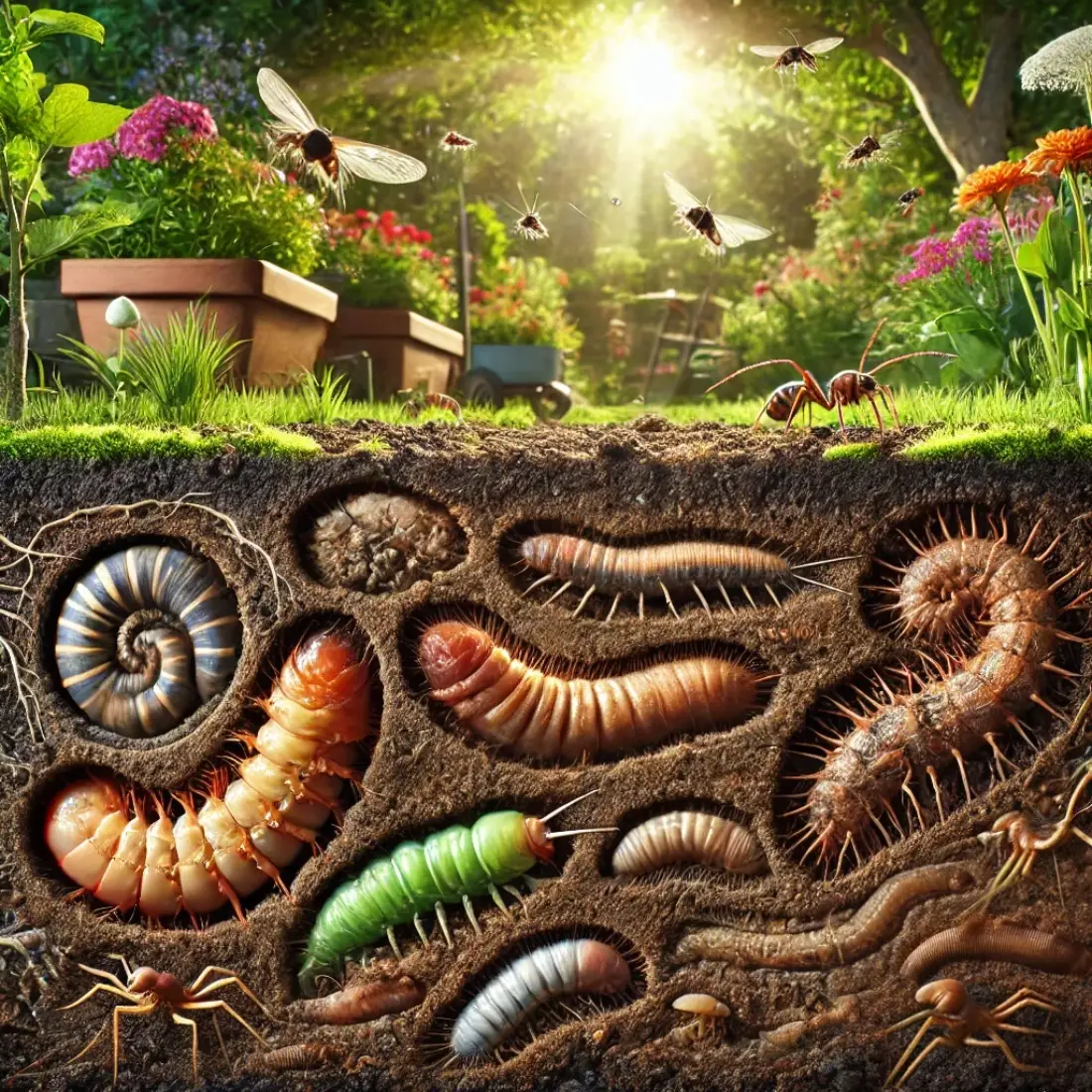Beneficial nematodes are microscopic, soil-dwelling organisms that play a crucial role in organic gardening. These natural predators target and eliminate common garden pests, such as grubs and root weevils, without harming plants, humans, or pets.
By integrating beneficial nematodes into your gardening practices, you can reduce reliance on chemical pesticides, promote healthier soil, and foster a more sustainable growing environment.
- Beneficial nematodes are microscopic organisms that naturally control a wide range of garden pests, making them a powerful tool in organic gardening.
- They specifically target harmful insects like grubs, root weevils, and fungus gnats without harming plants, beneficial insects, or humans.
- Using nematodes reduces the need for chemical pesticides, promoting a more sustainable and eco-friendly gardening practice.
- They improve overall soil health by contributing to nutrient cycling and enhancing soil structure.
- Proper application and maintenance are crucial to ensure their effectiveness in your garden.
How Beneficial Nematodes Work
Beneficial nematodes are microscopic, non-segmented roundworms that naturally inhabit soils and play a crucial role in controlling various garden pests. Unlike harmful nematodes that damage plant roots, beneficial nematodes are parasitic to insects, targeting and killing many common garden pests without harming plants, humans, or beneficial organisms.
Beneficial nematodes work by seeking out and attacking soil-dwelling pests through a highly efficient and natural process. These microscopic organisms enter their prey through body openings or by penetrating the insect’s outer layer.
Once inside, nematodes release symbiotic bacteria that quickly multiply, killing the host within 24 to 48 hours. The nematodes then feed on the bacteria and decomposing insect tissue, reproducing within the dead pest. As the nematodes mature, they exit the remains and seek out new hosts, continuing the cycle.
This natural pest control method effectively reduces populations of harmful insects without harming plants, beneficial organisms, or the surrounding environment. By targeting pests at their larval stage, beneficial nematodes prevent infestations before they start, making them a critical component of sustainable organic gardening practices.
Identifying Garden Pests Controlled by Beneficial Nematodes
- Common Garden Pests: Beneficial nematodes are effective against a variety of soil-dwelling pests, including grubs, root weevils, fungus gnats, and cutworms. These pests often attack plant roots, leading to weakened plants and reduced yields.
- Signs of Infestation: Look for symptoms like yellowing leaves, stunted growth, and wilting, which may indicate root damage caused by pests. Spotting these signs early can help you determine when to introduce nematodes.
- Nematode Species for Specific Pests: Different nematode species target different pests. For example, Steinernema carpocapsae is effective against caterpillars and cutworms, while Heterorhabditis bacteriophora targets beetle grubs and weevils.

How to Apply Beneficial Nematodes in Your Garden
Best Timing for Application: Apply nematodes during early morning or late evening when temperatures are cooler and the soil is moist. Spring and fall are ideal seasons, as these times usually coincide with peak pest activity.
Preparation: Before application, water your garden thoroughly. This helps nematodes move through the soil and find pests more easily. Avoid using chemical fertilizers or pesticides that could harm the nematodes.
Step-by-Step Application:
- Mixing Nematodes: Nematodes are typically sold in a powder or gel form. Mix them with water according to the package instructions.
- Application Method: Use a watering can, hose-end sprayer, or pump sprayer to distribute the nematode solution evenly over the soil.
- Post-Application Care: Keep the soil moist for at least two weeks after application to ensure nematodes remain active and can effectively target pests.
Maximizing Effectiveness: Apply nematodes during overcast weather or cover the treated area with mulch to protect them from UV light, which can be harmful. Repeat applications may be necessary depending on the severity of the pest problem.
Maintaining and Monitoring Nematode Populations
- Ensuring Longevity: To maintain healthy nematode populations, ensure that your soil remains moist and rich in organic matter. Avoid using chemical treatments that could kill nematodes or their prey.
- Monitoring Success: Regularly inspect your plants for signs of pest activity. Reduced pest damage and healthier plants are indicators that nematodes are effectively controlling the pest population.
Troubleshooting Common Issues
When using beneficial nematodes, certain environmental factors can affect their performance. Overwatering can drown nematodes, so ensure the soil is moist but not waterlogged. Soil temperature is also crucial, nematodes thrive between 55°F and 85°F. If the soil is too cold, their activity slows down, reducing effectiveness.
If it’s too hot, they may die. Additionally, UV exposure can kill nematodes, so apply them during early morning or evening when the sun is low. If pests persist, consider adjusting these conditions to enhance nematode survival and effectiveness.
FAQs About Beneficial Nematodes
What are beneficial nematodes, and how do they work?
Beneficial nematodes are microscopic roundworms that naturally control soil-dwelling pests by entering their bodies, releasing bacteria that kill the host, and reproducing within them. This process helps reduce pest populations in your garden.
Are beneficial nematodes safe for humans, pets, and plants?
Yes, beneficial nematodes are completely safe for humans, pets, and plants. They specifically target pests and do not harm other organisms.
How do I apply beneficial nematodes to my garden?
Mix the nematodes with water according to package instructions, and apply them using a watering can or sprayer. Ensure the soil is moist before and after application for the best results.
When is the best time to apply beneficial nematodes?
The best time to apply nematodes is during the early morning or late evening when temperatures are cooler. Spring and fall are ideal seasons, as they align with peak pest activity.
How long do beneficial nematodes remain effective in the soil?
Beneficial nematodes can remain active in the soil for several weeks to months, depending on environmental conditions like moisture and temperature.
Can beneficial nematodes be used in container gardening?
Yes, beneficial nematodes can be applied to container gardens to control soil-dwelling pests. Ensure containers have proper drainage to maintain suitable soil conditions.
How often should I reapply nematodes?
Reapplication may be necessary every few months, especially in areas with persistent pest problems or after heavy rainfall, which can wash nematodes away.
Will chemical pesticides harm beneficial nematodes?
Yes, chemical pesticides can kill beneficial nematodes. It’s best to avoid using such products in areas where you’ve applied nematodes.
Can I store leftover nematodes for later use?
Nematodes should be used as soon as possible after purchase. If necessary, they can be stored in a refrigerator for a short period, but check the packaging for specific storage instructions.
What should I do if I don’t see immediate results after applying nematodes?
Results may take a few weeks as nematodes establish and target pests. Ensure environmental conditions are suitable, and reapply if necessary.









